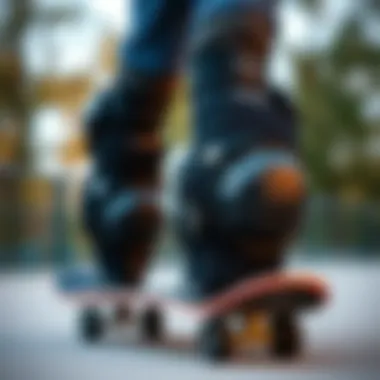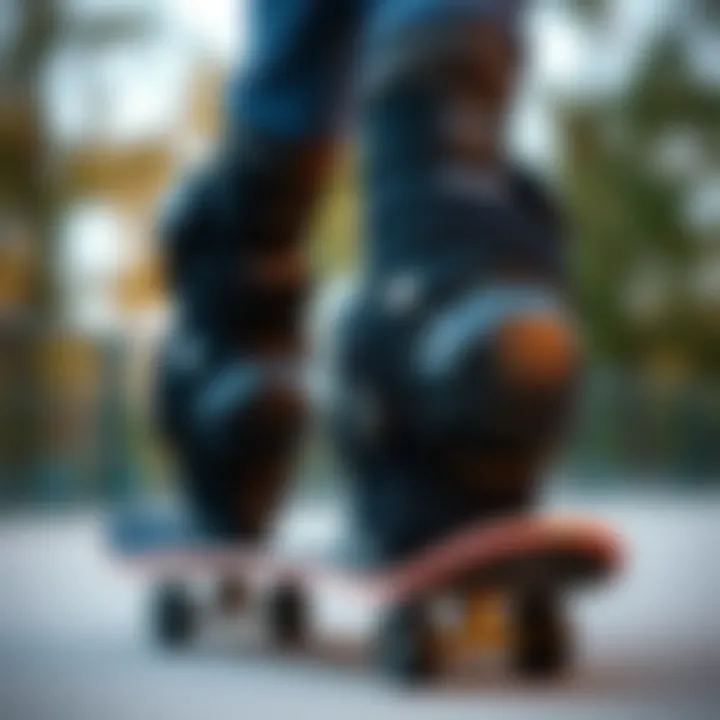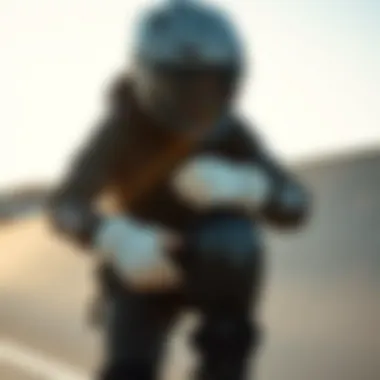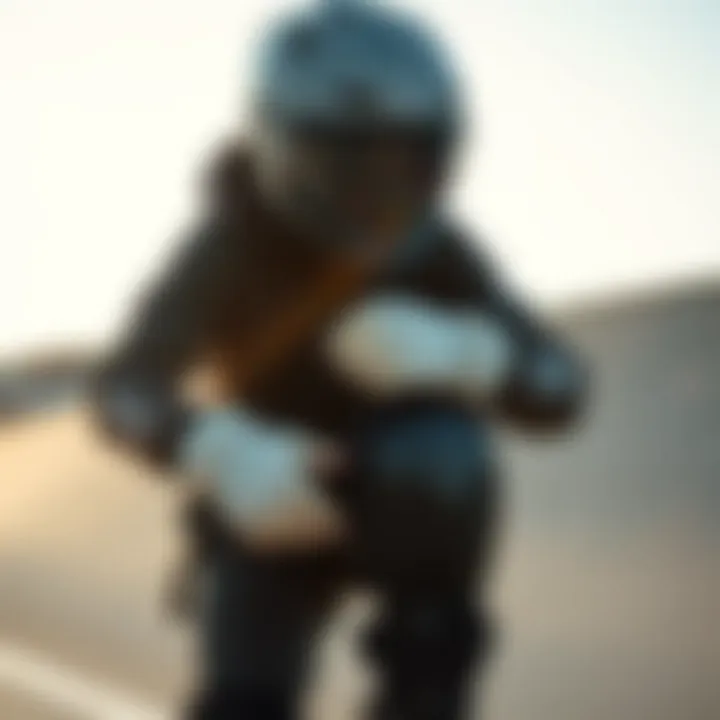A Comprehensive Guide to Skating Knee and Elbow Pads


Intro
Skating is not just a hobby; it’s a passion that drives many to seek the thrill of gliding smoothly over surfaces and performing daring tricks. However, with the adrenaline rush comes the ever-present risk of injury. That's where knee and elbow pads come into play. They are more than simple pieces of protective gear; they embody a commitment to safety while pursuing extreme sports. Understanding their significance can empower skaters, whether they are beginners or seasoned pros, to push their limits with confidence.
In this guide, we'll delve into the materials used in modern protective pads, explore innovative design features, and look into fitting techniques that ensure maximum protection and comfort. Additionally, we'll touch on maintenance practices to prolong the life of these essential items and examine the psychology behind the usage of protective gear in skating. This comprehensive analysis will highlight how wearing knee and elbow pads can enhance performance and significantly minimize injury risks.
Techniques and Tips
Participating in skating, it’s vital not just to wear protective gear, but to understand how to properly utilize it to your advantage. Here are some crucial techniques and tips that can help you become a better skater and maximize your safety.
Skill Development
Improving your skating skills isn't solely about practicing tricks and speed. It includes understanding how to fall properly. When you take a tumble, knowing how to roll or distribute your weight can lessen the impact on your elbows and knees. For instance, learning to bend your legs while descending can significantly prevent direct blows to your joints, allowing the pads to do their job effectively.
Practical Techniques
- Adjust Fit: Ensure that your knee and elbow pads fit snugly without being overly tight. A loose fit may mean they shift during movement, losing their effectiveness.
- Know Your Pads: Familiarize yourself with the pads' materials. High-density foam or hard plastic can offer different levels of protection, so choose based on your skating style and comfort.
- Check Before You Go: Always do a quick check on your gear before hitting the skate park. Check if there are any damages or wear and tear; don't ignore that frayed strap.
Common Mistakes to Avoid
- Skipping Protective Gear: Some might think they can skate without pads just this once. Skating without them can lead to a world of hurt, especially for beginners.
- Ignoring Comfort: If your pads are making you uncomfortable, you may not wear them properly, which can lead to less protection.
- Not Replacing Worn Gear: Don’t wait until your pads are barely holding together. Damaged gear offers no protection, so replace them regularly!
Gear and Equipment
The world of skating gear is diverse, and knowing what's essential can save you both time and money. Let’s explore what you really need and what new innovations are making waves in the skating community.
Essential Gear for Beginners
For anyone looking to dive into skating, these items should always be in your inventory:
- Knee Pads: Protect against falls and scrapes.
- Elbow Pads: Essential for protecting your arm joints when you take a spill.
- Helmet: A must-have for head protection. Don’t skimp on quality here.
- Wrist Guards: Less commonly used but vital for preventing injuries to your wrists.
Latest Innovations and Trends
Companies are consistently reinventing protective gear with the latest technologies:
- Some knee pads now feature moisture-wicking liners, keeping you dry and comfortable.
- Others incorporate flexible materials that adapt as you move, providing both comfort and protection.
Reviews and Comparisons
When it comes to choosing the right gear, individual reviews can shed light on what works best. Look for user experiences on platforms like Reddit or check reviews from dedicated skate gear sites. Websites like Skateboarder Magazine often provide in-depth reviews that can guide your selections.
Safety Measures
Skating can become perilous if safety isn’t prioritized. Here’s what to focus on:
Essential Safety Gear
Besides knee and elbow pads, here are other pieces of safety gear:
- Helmet: Always wear a certified helmet when skating.
- Protective Clothing: Long sleeves and pants can offer additional protection.
- Proper Shoes: Opt for shoes designed for skating, giving you both grip and ankle support.
Best Practices for Safe Participation
- Always skate within your skill level. There’s no race to master every trick overnight.
- Respect the skating environment. Be aware of others sharing the space and communicate.
- Warm up before skating to prevent injuries.
Injury Prevention and Management
It’s essential to be proactive when it comes to injuries. If you start to feel pain in your knees or elbows during skating sessions, consider taking a break or consulting with a medical professional. In the event of an injury, applying ice and rest can help manage pain. Always listen to your body; it often knows best.
Ending


In summary, knee and elbow pads aren't simply accessories; they are integral parts of a skater's arsenal. This guide emphasizes the multisided role they play in protecting skaters from injuries while simultaneously enhancing their performance. As you embark on your skating journey, let this knowledge empower you to make informed choices about your gear and techniques.
Importance of Protective Gear in Skating
In the thrilling world of skating, the adrenaline rush can sometimes take the driver's seat, overshadowing the necessity for protective gear. However, understanding the role of protective gear, especially knee and elbow pads, is crucial for anyone looking to glide, flip, or trick their way through this sport. With a focus on minimizing injuries while enhancing performance, the significance of this gear cannot be understated.
Understanding Skating Injuries
Skating is not without its risks. Whether you’re soaring on a skateboard or slicing through the air on rollerblades, falls can happen in the blink of an eye. Injuries can range from minor scrapes and bruises to more severe issues like fractures or dislocations. The Centers for Disease Control and Prevention (CDC) notes that the most common skating injuries involve the wrists, elbows, and knees. Concussions, too, can rear their ugly head if a skater doesn't take measures to protect their head — a point that is often overlooked.
To deepen the understanding, think about this: when a skater falls, they instinctively brace for impact. If they do so without protective gear, the likelihood of severe injury skyrockets. By wearing knee and elbow pads, the chances of averting a nasty injury increase substantially. After all, a lightweight and strong pad can absorb shock effectively, cushioning the blow when you hit the ground.
The Role of Knee and Elbow Pads
Knee and elbow pads serve as the frontline defense against the pavement. Their primary function is to provide protection, but it's not just about safety; it's also about enhancing confidence. When skaters are reassured by their gear, they often feel bolder in their moves. This psychological boost can lead to improved performance.
Here are several key points to consider about knee and elbow pads:
- Materials: Today's pads are made from high-density foam and durable plastics, providing a balance of comfort and protection.
- Design: Modern pads are designed to be low-profile, which means that while they offer ample protection, they do not compromise the range of motion.
- Breathability: Quality pads come with moisture-wicking fabrics, which help to prevent discomfort during extended skating sessions.
Many extreme sports enthusiasts may dismiss protective gear as unnecessary or cumbersome, but think about it: wearing knee and elbow pads is a smart investment in one’s health. Injuries not only hurt physically but can also dampen the thrill of skating for weeks or months on end. As the saying goes, "An ounce of prevention is worth a pound of cure."
"Skating remains an exhilarating pursuit, but don't cheap out on safety gear if you want to skate hard and skate often."
In summary, knee and elbow pads are more than just accessories; they're essential pieces of gear that mitigate risk, encourage skill advancement, and ensure your continued enjoyment of skating. It's best to prioritize these protective items just as you would with a skateboard or a good pair of wheels.
Material Considerations
When it comes to protective gear, taking a closer look at the materials used can make a world of difference. The right materials not only enhance safety but also improve comfort and longevity, which are vital for any skater looking to push their limits. As we explore this section, keep in mind that the fabric and padding you choose can significantly affect your skating experience.
Types of Padding and Foam
The padding in knee and elbow pads is your first line of defense against the hard ground and the unforgiving surfaces that skaters often encounter.
1. E.V.A. Foam
One of the most common materials used in protective gear is E.V.A. (Ethylene Vinyl Acetate) foam. Known for its lightweight nature, this foam provides decent shock absorption while allowing for flexibility during movement. It can handle impact, especially in tricks that might result in falls.
2. Polyurethane Foam
This type of foam offers a more rigid structure compared to E.V.A, providing enhanced protection in high-impact situations. However, it tends to be a bit heavier, which may not appeal to everyone. Balancing protection and performance is key here, especially for those engaged in advanced tricks.
3. Gel Padding
Some pads also utilize gel padding that provides superior shock absorption. The gel conforms to body movements, ensuring comfort and protection. However, during longer sessions, heat retention can be a downside, potentially making you feel uncomfortable if you’re sweating buckets.
4. Hard Caps
An additional layer of protection often incorporated into the design is the hard shell caps. Materials like ABS plastic or polycarbonate offer significant shielding from direct impacts. These hard caps can prevent fractures and serious injury, making them particularly useful for the more daring skaters who often find themselves in precarious positions.
In the quest for the optimal gear, skaters must weigh the protective qualities against comfort and flexibility. Whether it’s the lightweight E.V.A. foam for casual rides or the robust polyurethane foam for more intense sessions, understanding these materials is an essential step in ensuring safety and performance on the board.
Durability vs. Weight
As a skater, you often encounter this age-old dilemma: Should I prioritize weight or durability when selecting my knee and elbow pads? Each aspect presents its own set of considerations that can’t be overlooked.
Durability
When riding hard and taking falls, durability is essential. Pads made from tougher materials may withstand abrasions and impacts better than lighter alternatives. If you’re an aggressive skater or exploring rough terrain, investing in pads that can go the distance might be worth it. Usually, a pad with thicker padding or hard shells can fend off wear and tear effectively.
Weight
On the flipside, a lighter pad enhances mobility, making it easier to maneuver. An extra ounce can feel like a ton when you’re practicing kickflips or grinding rails. Thus, if mobility and ease of movement are essential for your skating style, you might lean towards lighter materials that still offer reasonable protection.
"Sometimes, a feather-light choice can lead to heavier falls. Each skater should find their balance between cushiony comfort and durable defense."
Finding the Balance
The key is combining both attributes. Some manufacturers incorporate hybrid technologies that merge lightweight and durable materials resulting in pads that offer the best of both worlds. For instance, while a primarily E.V.A. foam pad may be lightweight, adding a hard cap layer can boost its durability without compromising movement.
Design Features of Knee and Elbow Pads
When it comes to skating, the design features of knee and elbow pads play a pivotal role in ensuring safety and comfort. These elements not only enhance the protective aspect of the gear but also significantly impact the overall skating experience. When a pad is designed with care, it can make the difference between a nasty fall and a smooth landing.
The effectiveness of protective gear hinges on more than just the materials; it's about how those materials are shaped and configured to provide maximum protection without hindering movement. Hence, understanding the nuances of design features can aid in making informed choices that align with individual skating styles and preferences.
Ergonomic Shapes for Comfort


Ergonomics is the name of the game when it comes to protective gear, especially for skaters who frequently hit the pavement. Knee and elbow pads that boast ergonomic shapes fit the contours of the human body better. This means they move with you, not against you. For instance, many manufacturers design pads with an anatomical form that hugs the knee or elbow—allowing for a natural range of motion while providing adequate coverage.
Consider pads shaped with a low-profile design. These options keep the bulk down, allowing skaters to maintain agility and speed. This design approach can also lessen the intimidation factor often felt by newcomers to the skating community. Imagine someone strapping on oversized pads that take away from their ability to maneuver. It can feel restrictive, leading to a reluctance to push limits. Proper ergonomic design mitigates this issue.
In addition, comfort goes hand in hand with performance. Users frequently report that well-designed pads slip less, reducing distractions during a ride. Thus, proper ergonomic shapes are crucial for not just safety, but also for a more enjoyable skating session.
Adjustable Straps and Fasteners
Next up, adjustable straps and fasteners are absolutely critical features. The right fit is integral to the efficacy of any protective gear, and this is where these adjustable components come into play. When pads fit securely, they stay in place during use—this can prevent shifting that leads to exposed areas and, ultimately, injuries.
Take, for example, Velcro straps or buckles which allow for fine-tuning of the fit. Users can modify their pads to be tight enough to remain stationary, but not so much that they impede circulation or comfort. Everyone's body varies; some skaters might prefer their pads snug while others might opt for a more relaxed fit. Adjustable straps cater to these personal preferences, leading to a tailored experience.
Moreover, many skaters appreciate quick-release fasteners. These come in handy not just for convenience, but also during emergencies; being able to remove pads swiftly can be a literal lifesaver. In high-energy situations, the last thing anyone wants is to fumble with complicated fasteners when they need to adjust or eliminate gear in a hurry.
"The right fit with adjustable features can transform your skating experience. It’s about marrying comfort with utility for optimal performance."
Choosing the Right Size
Choosing the right size for your knee and elbow pads is not just a matter of fashion; it’s a fundamental aspect of safety and performance in skating. Protective gear that is ill-fitting can impede movement, cause discomfort, or worse, fail to provide adequate protection in case of a fall. It’s essential to grasp that each skater has unique body dimensions; even minor discrepancies in sizing can lead to significant challenges on the rink or the street.
When pads are too loose, they risk shifting during skating, leaving parts of the joint vulnerable to impacts. Conversely, overly tight pads can restrict circulation and hinder the natural movement of the joints. Thus, achieving a balance in fit is paramount. Whether you’re a thrill-seeker carving through a skate park or a novice taking your first strides, proper sizing can drastically enhance your confidence and performance.
Measuring Techniques for a Proper Fit
To ensure your pads fit just right, taking accurate measurements is key. Here are some straightforward techniques:
- Knee Pads: Measure the circumference of your knee joint while standing. Bend your knee slightly; this is crucial as it reflects how the pad will fit when in motion. Measure around the center of your kneecap, and then note the measurement.
- Elbow Pads: For elbow pads, measure around the elbow in a similar fashion. Keep your arm slightly bent as you measure around the joint. It’s essential to measure at the point where the elbow bends, ensuring a proper fit when you're actively skating.
- Use Manufacturer Size Charts: Most brands provide their sizing charts. Once you have your measurements, compare them to the chart to find your size. Each company might have different measurements for what constitutes a small, medium, or large pad, so this step is vital.
- Try Before You Buy: Whenever possible, always try on the pads. If shopping online, consider products with free returns or exchange policies. It’s better to double-check for comfort and fit.
If you follow these measuring guidelines, you’ll be one step closer to safeguarding your joints effectively while moving around on wheels.
Common Fitting Mistakes
Even seasoned skaters can make mistakes when it comes to fitting protective gear. Some of the most common pitfalls include:
- Ignoring the Size Chart: Skipping the size chart and opting for a guess is a quick recipe for discomfort.
- Overlooking Weight Distribution: With knee pads, skaters often fail to account for how weight will shift depending on the skating style. A lightweight pad might feel comfortable but may not offer full coverage.
- Underestimating Movement: Many forget that a pad must accommodate a full range of motion. Pads that feel snug sitting still may become too restrictive during a trick.
- Pairing Mismatched Sizes: Some skaters might wear different sized pads for each limb, which can lead to imbalance and increased risk of injury.
- Neglecting Comfort: Some might prioritize protection over comfort. While durability is key, if the pad isn’t comfortable, it’s likely to be discarded during a session, nullifying its protective purpose.
"Your gear should enhance your performance, not hinder it. A proper fit allows you to focus on skating rather than worrying about gear shifting or constricting your movements."
Recognizing these fitting mistakes can drastically improve the likelihood of having a safe and enjoyable skating experience. When you're sufficiently cushioned yet mobile, you can focus on the ride ahead.
Maintenance and Care
Taking care of your knee and elbow pads is no less important than choosing the right ones in the first place. After all, these trusty companions help to cushion every tumble and jolt while skating. If neglected, protective gear can become less effective over time. Keeping them clean and properly stored ensures they will serve you well, both in terms of safety and longevity. Skaters, especially those who tend to push their limits, should not underestimate the influence of maintenance on performance.
Cleaning and Sanitizing Pads
Let’s face it, knee and elbow pads can get pretty grimy. With all that sweat and dirt, the very materials designed to protect us can turn into a breeding ground for germs. Cleaning your pads regularly isn’t just about avoiding that funky smell—it's also a matter of health. A good wash reduces the risk of skin irritations or infections that can keep you off your board.
To clean your gear effectively, follow these steps:
- Read the Care Instructions: Check the manufacturer's guidelines first. Every pad is different and certain materials might require special treatment.
- Remove Padding if Possible: Some knee and elbow pads have removable liners. Take these out to wash separately.
- Use Mild Soap: A little gentle detergent mixed with lukewarm water works wonders. Avoid using harsh chemicals as they may deteriorate the padding.
- Scrub Gently: Use a soft brush or cloth to clean the surface. Be careful not to apply too much pressure—there’s no sense in creating more damage while cleaning.
- Rinse Thoroughly: Be sure to rinse out all soap residue. Any leftover product could irritate your skin when you skate.
- Dry Properly: Air-drying is best. Avoid direct sunlight as it can weaken the materials over time.
"A little bit of cleaning goes a long way! Your pads will thank you for the TLC."
Storage Best Practices
How you store your protective gear matters just as much as how you care for it. Improper storage can lead to mislaid pads, loss of shape, or even unnecessary wear and tear.
Here are some solid practices for storing your gear:
- Cool, Dry Place: Store your pads in an area that’s not too humid or hot. A dry room is ideal, as moisture can cause mildew.
- Use a Gear Bag: A dedicated gear bag can make a world of difference. It keeps your pads organized and protects them from external elements. Plus, you won’t have to rummage through a pile of equipment looking for them.
- Avoid Excessive Folding: Try not to fold pads too much. The foam inside should not be compressed unnecessarily, or it may lose its protective qualities.
- Check Regularly: Every few weeks, take a peek at your pads, even if you’re not skating soon. Ensure they aren’t developing mold or are wearing out unevenly.


Keeping these practices in mind can significantly prolong the life span of your protective gear. A little foresight now will go a long way in ensuring that your pads don’t let you down when you need them most.
Psychological Aspects of Wearing Protective Gear
In the realm of skating, wearing protective gear, particularly knee and elbow pads, goes beyond mere physical safety. The psychological dimension of donning such gear plays a crucial role in how a skater perceives their performance and enjoyment of the sport. When individuals step onto their boards, the mind is just as vital as the body, and understanding this interplay can offer insights into how protective gear influences confidence, focus, and overall experience.
The Influence on Performance
When a skater wears knee and elbow pads, there's not just a barrier against injuries; there's also an unmistakable boost to mental fortitude. Tightly secured pads can instill a sense of security that inspires skaters to push their limits. Confidence in protective gear often leads to bolder maneuvers and higher comfort levels when attempting new tricks.
The advantage isn’t merely psychological; it affects performance by changing how one approaches difficult maneuvers. For example, a skater wearing high-quality elbow pads might try a complex trick they otherwise would shy away from. The pads serve as a reminder of preparedness, encouraging risk-taking and skill development. In contrast, without adequate protective gear, anxiety about potential falls can hinder a performer’s abilities, restricting their movement and creativity on the board.
In discussions among skaters on platforms like reddit.com, many highlight how the comfort of protective gear contributes to an enhanced focus on their craft, allowing them to channel their energy into mastering techniques rather than worrying about injuries.
Overcoming Fear of Falling
Another significant psychological aspect of wearing knee and elbow pads is the ability to quell the ever-present fear of falling. For many, the thought of hitting the ground hard can be paralyzing. This apprehension often stifles enthusiasm and diminishes the thrill of skating.
Protective gear acts as a safety net – even if it’s psychological. Knowing that their limbs are cushioned can help skaters take the leap and try stunts they would have avoided otherwise. This creates a motivating cycle: as they experience successful falls with minimal impact, their fear diminishes. Those small victories gradually build resilience and mastery over one’s skills.
A study conducted by psychological professionals noted that skaters who discussed protective gear as a safety measure were more likely to engage in challenging activities without the overwhelming anxiety that sometimes comes with the sport. The presence of gear creates a perception shift, emphasizing safety and capability rather than vulnerability. The mental hurdle begins to fade, reinforcing the idea that with the right protections, one can enjoy their passion with far fewer worries.
As we navigate these psychological avenues, it becomes clear that wearing protective gear is not just about bruises and scrapes. It’s about fostering a mindset that enhances enjoyment, performance, and personal growth on the board. Skating does not exist in a vacuum, and when skaters arm themselves with knowledge and the right equipment, they equip themselves for both physical and mental victories.
Market Trends in Protective Gear
In today’s fast-paced world of skating, keeping up with the latest trends in protective gear is not just beneficial—it’s paramount. The evolution of skateboarding and extreme sports has led to a greater emphasis on safety equipment that doesn’t just protect but also enhances performance. Understanding the market trends provides insight into what’s on the horizon for knee and elbow pads, allowing enthusiasts to make informed decisions that pair safety with their adventurous spirit.
Innovations in Technology
The skating community continually pushes the limits of engineering, leading to groundbreaking technologies incorporated into protective gear. For instance, the advent of smart materials has changed the game considerably. Impact-resistant foams that adapt to the force of falls are now being used. These materials respond differently based on the severity of an impact, which could mean cushier landings on minor spills but the necessary rigidity to withstand hard knocks.
Furthermore, companies are exploring wearable technology, such as pads integrated with sensors that can analyze the skater’s technique. Imagine wearing wristbands that connect with your pads and provide real-time data on your movements, assessing your balance or suggesting improvements. This tech makes gear not just a safety companion but a coach.
In addition to innovation, the market has seen a shift towards more customizable options. Skaters can now choose colors, patterns, and even adjust the level of comfort and protection based on their personal style or skating discipline. The versatility accommodates both street skaters and vert riders, ensuring that everyone can express their individuality while prioritizing safety.
Sustainability in Production
As environmental concerns continue to ripple across all industries, protective gear is no exception. Skaters are increasingly drawn to brands that prioritize eco-friendly practices in their manufacturing processes. Sustainable materials like recycled plastics and organic fabrics are becoming mainstream. Not only do they have a smaller environmental footprint, but they appeal to a growing segment of eco-conscious consumers who demand choices that align with their values.
Moreover, many companies are beginning to offer programs for recycling old gear, allowing skaters to dispose of their used pads responsibly. This practice ensures that even end-of-life products find a purpose rather than ending up in landfills. Transparency in sourcing and production processes has also become a focal point; brands that disclose their materials and environmental impacts gain a competitive edge.
"As a skater, the gear you choose not only protects you but sends a message about what you stand for. Choosing sustainable options isn’t just smart—it’s a statement."
This intersection of technology and sustainability illustrates a dynamic market landscape, where innovative approaches to gear not only focus on the individual’s safety but also contribute to a broader ecological well-being. Thus, understanding these trends empowers skaters to select protection that reflects their ethics and enhances their performance while making a statement about their commitment to the planet.
The Future of Skating Protective Gear
As skating evolves, the future of protective gear like knee and elbow pads stands to reshape the way enthusiasts approach safety. Keeping up with current demands for higher performance, comfort, and sustainability, manufacturers are starting to think outside the box. The fusion of modern technology with traditional materials is not merely a trend; it’s a necessity for pushing the limits of what’s possible in skating.
Emerging Materials and Techniques
The evolution of skating gear is heavily reliant on advancements in materials technology. Gone are the days when foam padding was the only option available. Today’s pads incorporate a variety of materials designed to offer maximum protection while remaining lightweight.
- D3O Material: This intelligent material is soft and flexible during wear but hardens upon impact, providing excellent shock absorption. As a bonus, it allows for a more streamlined design which contributes to comfort without sacrificing protection.
- Carbon Fiber Reinforcements: While carbon fiber might leave some of us scratching our heads, its incredible strength-to-weight ratio makes it an ideal candidate for toughening up pads without adding extra weight.
- Bio-Based Foams: The rise of eco-conscious practices is filtering into skating gear too. Bio-based foams made from renewable resources offer safety and sustainability, catering to a new generation of environmentally aware athletes.
In addition, smart technology integration is becoming a pivotal trend. Wearable sensors that monitor impact forces can provide real-time feedback to the user. Imagine having a system that alerts you when a situation might be dangerous, allowing for adjustments before attempting your next stunt! These cutting-edge techniques are paving the way for a safer skating ecosystem that minimizes the risk while enhancing the thrill.
Predictions for the Next Decade
Looking ahead, it's intriguing to consider how the landscape of skating protective gear may transform in the next ten years. A handful of trends are likely to shape this evolution:
- Customizable Gear: Advances in 3D printing may allow skaters to customize their knee and elbow pads to their exact specifications. Individuals could go from generic pads to a tailor-made fit that enhances comfort and performance.
- Increased Focus on Feminine Designs: There’s a growing call for inclusivity in the extreme sports world. Expect to see more female-oriented designs that cater specifically to women's anatomical differences, giving female skaters enhanced options.
- Smart Gear Integration: As the Internet of Things becomes more pervasive, protective gear will likely include advanced monitoring systems that not only assess impacts but also analyze balance and technique. This is particularly beneficial for beginners and those looking to enhance their skating skills.
“The future isn’t merely something you enter; the future is something you create.”
- Sustainability: The thumbprint of sustainability will be distinctly visible, with a marked preference for materials that are not only tough but environmentally friendly. The industry will see increased pressure to recycle and recover used materials, making environmental consciousness a significant facet of production.
In summary, the future of skating protective gear lies in innovation, personalization, and responsibility. As these elements come together, they’ll not only protect skaters but encourage them to push boundaries while keeping safety at the forefront."







